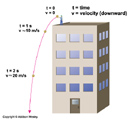
Thursday, June 6th 2002. Reading: Cosmic Perspective Chapter 5
When he was 20 years old he bought a book on astrology at a fair, "out of curiosity to see what was in it." He came upon a figure in the book that he did not understand because it involved trigonometry and he was ignorant of trigonometry. So he bought a book on trigonometry. When he couldn't follow the geometrical arguments in that book he bought himself a copy of Euclid's Elements of Geometry. Two years later he invented differential calculus.
In 1666 he was an undergraduate at Cambridge University when an outbreak of plague forced him to spend a year away in the isolated village of Woolsthorpe, where he had been born. In that year he invented differential and integral calculus, made fundamental discoveries on the nature of light, and began to think on the law of Universal Gravitation. It was quite a year.
Velocity: Speed in a specific direction. Velocity is specified by a Vector. It has both magnitude and direction.
Acceleration: The time rate of change of velocity (speed and/or direction). Acceleration is also a vector.


Angular Momentum: momentum of spinning/rotating or revolving. It is also a vector and is also conserved. Mathematically:
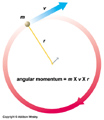
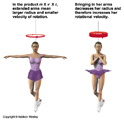
Torque: The time rate of change of angular momentum. Also a vector. Mathematically:

We have to apply a force. The force that we need to apply must constantly change the direction of of the object's motion without altering the tangential speed of the object. We can show this with an object tied to the end of a string. If we swing the object around in a circle above our heads the force that is causing the object to go around is the tension in the string. You can feel the tension as you swing the the object. If we were to suddenly cut the string the object would continue off on a tangential line from the spot it was released. It will not continue on in a curved path.
The force that keeps planets, moons, etc. in orbits is gravity, the natural attraction of all matter to other matter. We can visualize how to put something in orbit by imagining firing a canonball from a very high mountain. The greater the initial velocity we give the ball the farther down range it will go before falling to the Earth. If we get it at just the right speed it will continue to fall toward the Earth, but the Earth's curvature will continue to curve away from it and it will make a full circle and eventually hit the back end of the canon.
So an object in orbit is indeed experiencing gravity. For example the Space Shuttle when it is in orbit around the Earth is always falling toward the Earth, but it is also heading tangentially at just the right speed to stay in a circle (or ellipse). So it is always under the influence of gravity. The astronauts appear weightless because they and the Shuttle are all falling together at the same rate.
He studied Kepler's 3rd law of planetary motion and his own laws of motion to come up with a Universal Law of Gravitation. Given two masses, m1 and m2 the force between them is given by
For example the force of attracttion that your body feels toward the Earth is the same force of attraction that the Earth feels toward you. But since Earth is way more massive than you its acceleration is much, much, much less than yours. You can see this by relating the law of gravitation to Newton's second law.
IMPORTANT: If m2 << m1 then we may ignore m2 such that m1 + m2 ![]() m1 then the relation becomes
m1 then the relation becomes
This fact can be used to measure the mass of the Sun. For all planets in the Solar System we may write
That means if you have mass, m, and are standing on the surface of a planet with Mass, M, and Radius, R, then the force of gravity acting on you is
Now notice also that it is true by Newton's 2nd Law that
NOTE: the force you feel due to gravity is your weight
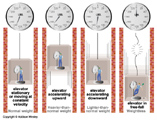
Escape Velocity
If you wish to escape from the surface of a gravitating object there is a special velocity you must have in order to accomplish this. It's called the escape velocity. The best way to understand this is to think in terms of energy. In order to be able to escape from a planet you want to have an initial velocity that will make your total mechanical energy be at least zero or greater (unbound). Recall that the total mechanical energy is written as
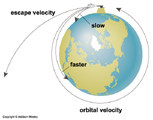
An interesting idea that was raised not long after Newton's time was that if an object were to have just enough mass enclosed in a small enough radius the escape velocity would be greater than the speed of light, and then not even light could escape the surface of this object. It was then known as a "Black Star". Today this is rather similar to the idea of a Black Hole.

The conic section that an orbit will exhibit depends on its total energy. If the total energy of the system is negative then the orbit is bound and is an ellipse. If the energy is exactly equal to zero then it is unbound and follows a parabolic shape. If the energy is positive, then the orbit is unbound and follows a hyperbola. This is summed up in the following table...
| Energy | Bound/Unbound | Shape | Eccentricity |
| E < 0, minimum | Bound | Circle | e = 0 |
| E < 0 | Bound | Ellipse | 0 < e < 1 |
| E = 0 | Unbound | Parabola | e = 1 |
| E > 0 | Unbound | Hyperbola | e > 1 |
The Moon exerts a differential pull on Earth and this is the cause of the tides on Earth.
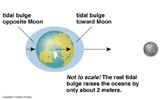
The Sun also contributes to this, but the Sun's tidal distortion on Earth is half that of the Moon's because of its distance. The maximum tides occur when the Earth, Sun, and Moon are all in a line (new and full Moon). The minimum tides occur when the Moon is in either quarter phase.


This process causes a kind of friction that slows the Earth's spin. In doing so Angular momentum must be conserved and so the Moon's orbital angular momentum increases and it moves farther away.
This friction is a kind of energy loss of the system. The energy loss continues until a minimum amount of friction is present. The Moon was likely spinning faster on its axis, but the Tides raised on it surface by Earth slowed it into lock-step with its orbit. This is called orbital resonance. It is a minimum energy loss state.
The Earth will one day reach a similar state. Then the day will be as long as a month, which will also be longer than the current month because the Moon will be farther away. The Moon's angular size in the sky will be smaller and there'll be no more total solar eclipses. Also Earth will show only one face to the Moon just as the Moon currently does to Earth.
This will actually never happen because the Sun will die out and destroy Earth first.
Return to Class Notes Page